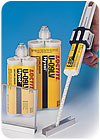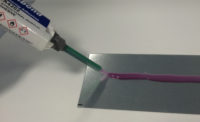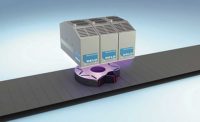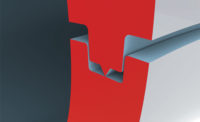
Two-part epoxy, acrylic, silicone and urethane adhesives are commonly used in assembly. These adhesives deliver excellent performance in a wide range of applications, but they can be difficult to dispense.
The processing constraints for each adhesive must be addressed when choosing dispensing equipment. If the wrong equipment is used, the process could be messy; the material may cure too slowly, too quickly or not at all; and the bond may not perform as expected. Fortunately, a variety of high-tech equipment is available to ensure a controlled mixing and dispensing process on the assembly line.
Since all two-part adhesives are different, understanding the adhesive formulation will assist assemblers in choosing a dispensing system. The type of adhesive can influence many equipment variables, such as the reactivity of dispensing components; the maximum or minimum shot size; temperature and humidity control; and how the material is supplied and fed to the valve.
Epoxies bond very well to a wide variety of substrates. They typically offer excellent cohesive and tensile strength, very good chemical resistance, and good heat resistance. These adhesives can also fill large volumes and gaps. Epoxies can be highly filled and highly viscous, which can make dispensing difficult. For example, engineers need to take steps to prevent the filler material from settling in the material reservoir.
Urethanes are tough polymers that offer flexibility and excellent peel strength. They adhere to plastics and rubber better than epoxies. They produce a bond with soft regions that add flexibility to a joint, and rigid regions that contribute cohesive strength, temperature resistance and chemical resistance. Urethane adhesives tend to react with ambient moisture, which can cause cosmetic and curing issues.
Silicones are highly elastomeric and are known for their resistance to weather, high temperatures and polar chemicals. They also have excellent sealing capabilities. They can be formulated for adhesion to a variety of substrates, unlimited depth of cure, fast fixturing and curing, and excellent tear resistance. Available in viscosities ranging from pourable liquids to nonslumping pastes, silicones are sensitive to moisture, which can present challenges during the dispense process.
Acrylics are gap fillers that offer good environmental and thermal resistance and excellent tensile and peel strength. Highly flexible, acrylics fixture faster than epoxy and polyurethane adhesives and bond well to many substrates, including metals and plastics. They are ideal for applications requiring long-term fatigue resistance and durability. Although they are incompatible with some metals commonly used in dispensing equipment, acrylics will not react with specialized wetted components.
Mixing and Dispensing Options
Correct mix ratios and thorough mixing are essential to maximizing the performance of two-part adhesives. Assemblers have several options for mixing and dispensing these materials, and each has distinct advantages and disadvantages.
Although labor-intensive, hand mixing requires little or no capital investment in equipment. Engineers must carefully measure and mix the resin and hardener. Any mistakes in calculating and measuring the required amounts of each part will result in incorrect mix ratios and incomplete blending that will ultimately lead to assembly failure. Hand-mixed adhesives are typically applied by hand, which can be difficult and time-consuming. As a result, hand mixing is not suitable for high-volume manufacturing.
For low- and medium-volume manufacturing, many two-part adhesives are available in premeasured cartridges for use with static mix nozzles. Typically available in 35- to 490-milliliter cartridges, these side-by-side packages ensure the correct mix ratio and eliminate the mess and inaccuracy associated with hand mixing and application. Dual-cartridge dispensing saves time for assemblers who do not use bulk adhesive. However, the cartridges are typically more expensive than bulk-packaged adhesive.
Dual cartridges can also present dispensing challenges. For instance, adhesive in the tip of the cartridge can sometimes cure, causing "blow-by," or blocked adhesive that leaks past the plunger in the back of the cartridge. Before application, assemblers must check plunger depth to ensure the correct mix ratio. Cartridges also require some type of dispenser, whether it is a handheld gun or a semiautomatic unit.
Handheld cartridge dispensers are portable and inexpensive, but adhesive viscosity can affect the ease of dispensing. Consistent application of material can sometimes be difficult. More expensive semiautomatic equipment delivers consistent deposits of the product using controlled application of time and pressure. However, these operator-controlled systems may not be as portable as handheld dispensers.
For medium- and high-volume production, automatic meter, mix and dispense (MMD) systems are the technology of choice. Engineered exclusively for use with bulk-packaged adhesives, MMD systems are typically positive-displacement equipment. That is, a precise amount of fluid is expelled from the pump during every cycle, regardless of fluid temperature or viscosity. MMD systems are available in either reciprocating designs for single and multishot dispensing, or rotary designs for dispensing uniform, continuous beads of adhesive.
How MMD Systems Work
A single-acting piston pump is the workhorse of MMD technology. The stroke length of the piston determines the volume of adhesive dispensed. The only way to change shot volume is to limit the depth of the piston's stroke into the pump tube. Requiring no adjustment to maintain mix ratio, fixed-ratio MMD machines are most effective for high-volume production environments. Variable-ratio MMD machines are best in applications where adhesive volume or chemistry change regularly, such as prototyping or small-scale production facilities.
Once adhesive is in the pump tubes, MMD equipment pumps each component through hoses to a valve that dispenses the material through a mix nozzle. The dispense valve delivers a guaranteed and dependable shot size and eliminates dripping from the nozzle tip. The dispense valve also helps to direct the flow of materials into the mix nozzle to ensure complete mixing of the adhesive.
All MMD equipment requires some type of feed package, ranging from simple, low-cost gravity tanks to pumps that feed adhesive from a drum or pail. The appropriate feed package depends on the individual process and adhesive requirements. For example, nitrogen can be pumped into a feed tank to protect moisture-reactive adhesives. Or, the feed tank can be pressurized with air or other gases to boost material flow.
MMD systems can be built with a wide range of control options. Operator-controlled dispense systems are used when large volumes of material are needed and precise shot size does not matter. Flow is initiated and stopped by the operator. Semiautomatic systems deliver precise, repeatable shots of adhesive. An operator controls the system, but only to start the dispensing cycle. Volume is controlled either mechanically or electronically.
The answers to two general, process-related questions will quickly determine if an MMD system is the best equipment for an application.
The first is, "What material is being dispensed?" This question immediately provides information on process constraints related to the adhesive itself. For example, cartridges may not be appropriate for moisture-sensitive adhesives, because moisture can penetrate the package. Hand mixing will also expose the adhesive to ambient moisture. Using an MMD system would be the ideal choice, because the equipment can be configured with nitrogen blankets to significantly reduce exposure to moisture.
Similarly, MMD systems can be configured to dispense highly filled, highly viscous and highly reactive materials. A mechanical agitator in the feed tank will keep filled adhesives well mixed and ensure uniform distribution of the filler. Heat will thin highly viscous materials, making them easier to dispense. Dispense chambers can be made of certain materials, such as stainless steel, to minimize or eliminate adverse chemical reactions with the adhesives.
Adhesives with short work lives are ideal for MMD systems, which can quickly mix and apply the two components. For adhesives that must be mixed and applied at elevated temperatures, MMD systems can be equipped with heaters to regulate the temperature of each adhesive component individually, a nearly impossible task for manual or dual-cartridge dispensing.
The second question is "What are the process requirements?" The volume of adhesive dispensed per part and the number of parts assembled per day can often make the equipment decision very simple. Applications that require a large amount of adhesive to be dispensed due to high volume per part or high throughput of parts, cannot rely on hand mixing or cartridges for economic and convenience reasons. Bulk adhesive is less expensive than cartridges, a savings that is often higher than the cost of the MMD system itself.
The amount of adhesive per part is also important for quality purposes. Consistently dispensing the same amount of adhesive on every part is almost impossible to do by hand or with dual-cartridge dispensers. MMD systems dispense the same shot or bead size time after time, ensuring that just enough adhesive is used for each part to ensure quality and prevent waste.
Aside from dictating total adhesive usage, the production rate determines the time available for dispensing. In a high-volume production environment, adhesive may be applied in seconds, leaving no time to mix new material or reload cartridges. MMD systems work off large feed tanks that can be refilled with little or no downtime.
Dispensing Checklist
What Material Is Being Dispensed?
- What is the adhesive chemistry?
- Are the materials filled or unfilled?
- What is the adhesive's optimum mix ratio?
- What are the viscosities of each adhesive component?
- What is the work life of the mixed product?
- What is the ideal working temperature?
- What packaging options are available for this adhesive?
What Are the Process Requirements?
- What is the production rate?
- How much time is available for dispensing per part?
- How much adhesive will be applied per cycle?
- What is the dispense pattern?


